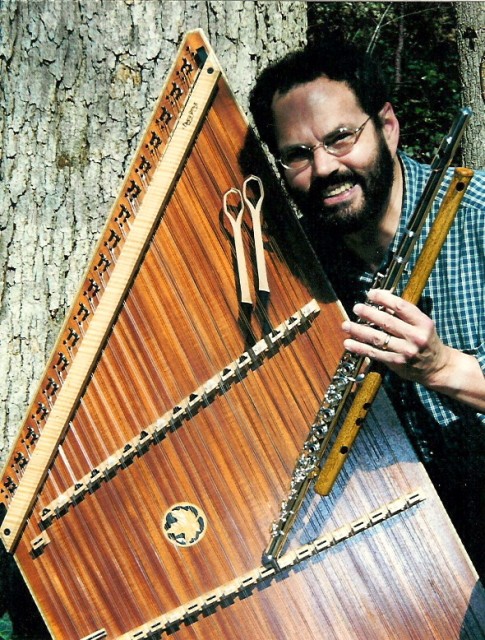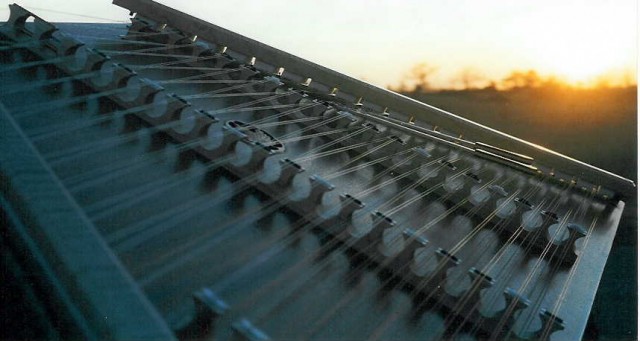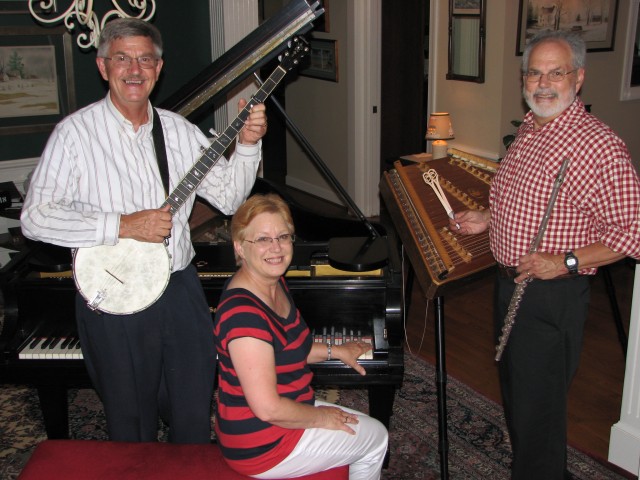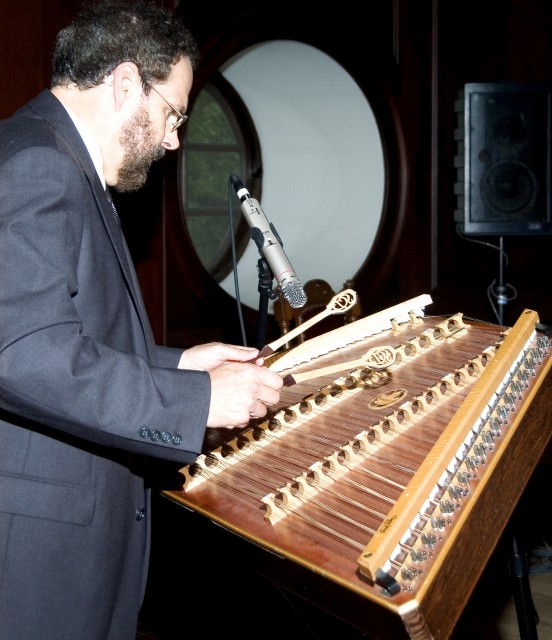In 1999 I wrote a personal account about my life with music up to that point and particularly in relation the hammered dulcimer. Perhaps it will be of interest!
Timothy's Blog
Visually on the hammered dulcimer the "shape" of a three-note chord (a triad) is often a triangle, with the "vertices" the places where the hammers strike.
Around 1990, as a relatively new player, I wanted to practice playing triangles in a repeating right-left-right-left pattern, so one evening I started near the top of the dulcimer and played the E minor chord then moved down to the next position (G major) and continued downward in this way till an even number of measures seemed to call for a change. I inserted a few other figures as part of this for interest (moving up a note for a moment, etc.), but the pattern was basically straightforward as a triangle study.
...People often ask me about the origin and history of the hammered dulcimer, and usually they have no idea that it has the popularity and heritage that I tell them about. It's a widespread, very international, musical instrument! Many Americans don’t know that it ever existed at all till they see my own instrument where I’m out playing, and they commonly assume that it’s some mountain instrument developed in the Blue Ridge or such (though I don't play it in a style that should lead to that assumption). So I get to enlighten them the way I was enlightened thirty-some years ago when I first saw one myself!
It's even considered a national instrument in a number of countries such as Hungary, India, China, and Iran.
...Harpsichords and clavichords had been in development for a few centuries when an Italian named Bartolomeo Cristofori decided in the late 1600s to try to adapt the idea of the hammered dulcimer to the chromatic keyboard design.
Harpsichords had only one loudness (known to us as “quiet”), and their tone was essentially always the same plucking-crow-quill sound as well. Cristofori recognized that applying the hammer concept could open the way to a great range of volume and tone --- so he worked on making a sophisticated key assembly that could handle the varied actions of swinging a hammer at the strings. Now, instead of the player’s moving two hammers around on a diatonic (do-re-mi) pattern of notes, he or she would be able to use all ten fingers to push buttons (keys) that swung hammers that were already oriented in front of their chromatic notes. (And separating the right and left hands for different musical roles could create the effect of a "duet" that we're so familiar with in keyboard playing.)
...Are you a musician who is tied to the page? Do you need to have notes printed in front of you in order to play? Or do you have to depend on a carefully rehearsed repertoire? Do you require a chord chart so you know the right harmonic structure? Or are distinct melodies your only option when you play?
Here's an example of how totally 'out of the blue' playing can be beneficial:
...Information about Cookies
A cookie is a small piece of data (usually a text file) that a website asks your browser to store on your computer or mobile device. It enables the website to remember your actions and preferences (such as login, language, font size and other display preferences) over a period of time, so you don’t have to keep re-entering them whenever you come back to the site or browse from one page to another. Most browsers support cookies, but users can set their browsers to decline them and can delete them whenever they like. Cookies can be used to collect and store user data while connected to provide you with requested services. More information about cookies can be found at http://www.aboutcookies.org.
In addition to cookies that remember your preferences mentioned above, cookies are used for the purpose of purchasing items off this website, and for login and user profile details should you provide them by creating an account or signing up for the blog posts or newsletter.
Third party cookies are also used on this site. Specifically, Google Analytics is used on this site -- a popular web analytics service provided by Google, Inc. Google Analytics uses cookies to help us analyze how users use this site. It counts the number of visitors and tells us things about their behavior overall – such as the typical length of stay on the site or the average number of pages a user views.
The information generated by the cookie about your use of our website (including your IP address) will be transmitted to and stored by Google on servers in the United States. Google will use this information for the purpose of evaluating your use of our website, compiling reports on website activity and providing other services relating to website activity and internet usage.
Google may also transfer this information to third parties where required to do so by law, or where such third parties process the information on Google's behalf. Google undertakes not to associate your IP address with any other data held by Google.
If you have Adobe Flash installed on your computer (most computers do) and utilize audio or video players, Google Analytics will try to store some additional data on your computer. This data is known as a Local Shared Object or Flash cookie. This helps us to analyze the popularity of our media files.
Finally, this website makes use of Google Maps. Google Maps is used to provide locations for Timothy Seaman's performances. In clicking on a performance location, you can allow or deny Google Maps knowledge of your location for purposes of getting directions from your location to the event site.
You can control and/or delete cookies as you wish – for details, see aboutcookies.org. You can delete all cookies that are already on your computer and you can set most browsers to prevent them from being placed. If you do this, however, you may have to manually adjust some preferences every time you visit a site and some services and functionalities may not work.
Your failure to control and/or delete cookies for this site constitutes your acceptance of cookies as outlined above.







